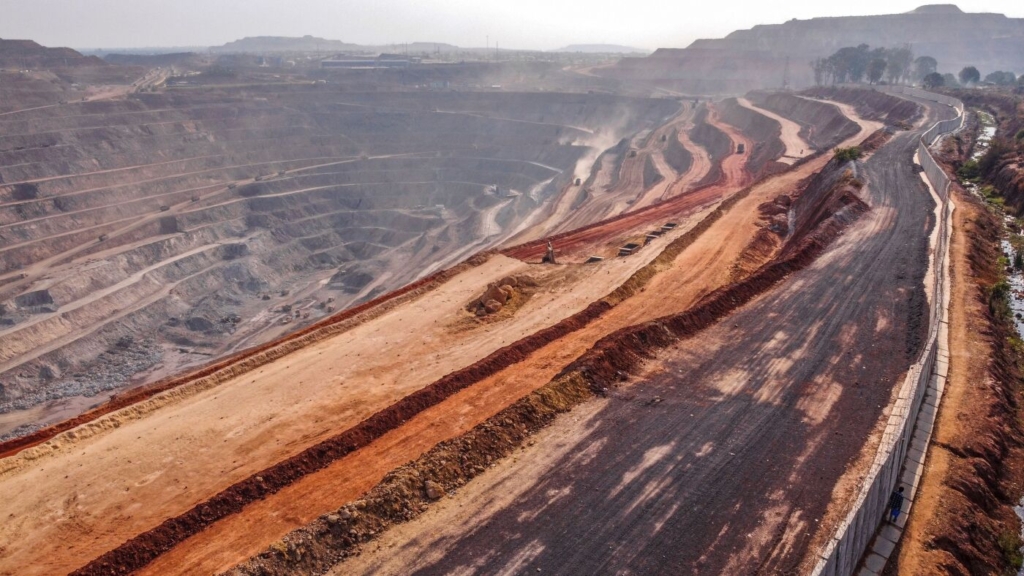A general view of the Chinese mining company COMMUS (Musonoïe Mining Company Global SAS), downtown Kolwezi.
Junior Kannah/AFP
hide caption
toggle caption
Junior Kannah/AFP
KOLWEZI, Democratic Republic of Congo — Little about Kolwezi, a small city in southern Democratic Republic of Congo, hints at its global importance.
Nondescript and ringed by slag heaps, pits and quarry lakes, the city is home to some of the largest copper and cobalt mines in the world.
Now, Kolwezi is at the center of U.S.-Chinese competition over critical minerals.
Earlier this year, mining firms began shipping ore along a U.S.-backed railway that terminates in Angola’s Atlantic port of Lobito. A massive infrastructure project is focused on this rail line — which is viewed as a bid to counter China’s stranglehold over critical minerals in central Africa.
President Biden is visiting Lobito Wednesday to promote the so-called Lobito Corridor, for which the U.S., European Union, G7, and private firms are mobilizing billions of dollars.
It’s the last stop of a whirlwind three-day trip to Africa — the first and only trip to the continent during his presidency — and most likely the last international trip before he leaves office in January.
President Biden leaves the National Museum of Slavery, in the capital Luanda, Angola on Tuesday, Dec. 3.
Ben Curtis/AP
hide caption
toggle caption
Ben Curtis/AP
Russell Fryer, the CEO of British-listed firm Critical Metals, says that the project will be a boon for the copper-cobalt mine he is developing in Congo.
“We would like to sell our products, our copper concentrate, to Europe or North America,” he says, adding that there is now an “scramble for assets” in central Africa, with western countries increasingly vying to compete with the Chinese.
The Lobito Atlantic Railway, which stretches over 800 miles, drastically cuts down on transportation times from Congo’s copper and cobalt mining region. The port of Lobito is also situated on the Atlantic — closer to the U.S. and Europe than Africa’s more widely used Indian Ocean ports.
A man checks bags of sulfur being loaded onto a train at Impala Terminals, Kolwezi, Democratic Republic of Congo.
Emmet Livingstone/NPR
hide caption
toggle caption
Emmet Livingstone/NPR
Once completed, the railway line is also due to reach copper-rich Zambia.
But Congo remains the true prize. The impoverished and unstable country has staggering mineral wealth, with some of its richest deposits concentrated around Kolwezi. More than 70% of the world’s cobalt, a critical metal used in electric-vehicle batteries and jet engines, comes from Congo, for example. The country is also the second-largest producer of copper.
But despite the recent U.S. push to increase its footprint in critical minerals, China remains overwhelmingly dominant. Its firms own over 80 percent of Congo’s copper mines, according to the Lobito Corridor Investment Promotion Authority. And they enjoy a similarly commanding position in cobalt extraction.
On top of all of this, China’s Belt and Road Initiative has invested heavily in infrastructure, ports, roads and railways across the continent.
In Kolwezi, the Chinese presence is ubiquitous. Billboards and buildings are plastered in Chinese characters, and the city has a string of Chinese-run casinos.
Most experts view the Lobito railway as only a first step, following years of U.S. neglect of the region.
“It’s just a railway, nothing more,” says Christian Geraud Neema, a China-Africa analyst and nonresident scholar in the Carnegie African Program.
He added that the U.S. can hardly compete with China because it has no companies of its own on the ground. Neither will Lobito hamper Chinese industry. Any company — including Chinese ones — can also ship ore via the port.
U.S. officials have stressed that they are not forcing countries to pick a side, and that the Lobito Corridor is intended as a development program that will benefit Angola, Congo and Zambia.
Marie Banza Ngoy, 60, poses for a photo by the stream where she digs for copper, on the outskirts of Kolwezi, Democratic Republic of Congo.
Emmet Livingstone/NPR
hide caption
toggle caption
Emmet Livingstone/NPR
Still, the geopolitical competition means little to most Congolese people, who see little benefit from their country’s enormous mineral deposits.
Congo is seen as one of the most corrupt countries on Earth, ranking 162 out 180 in Corruption Perceptions Index, according to the NGO Transparency International.
In Kolwezi, hundreds of thousands of people survive by prising ore out of the ground with rudimentary tools such as spades and picks.
“It’s very hard, it’s very hard,” says Marie Banza Ngoy, a 60-year-old woman who uses a spade and a plastic bucket to pan for chunks of green copper ore, in a stream below an industrial slag heap. For a day’s work, she earns the equivalent of $2.
A testament to Chinese presence at all levels of Kolwezi’s minerals trade: Ngoy says sells her ore to Congolese middlemen, who sell the minerals on to Chinese traders.











Yorumlar kapalı.